This feature highlights three crosses located on Inis Cealtra, an island in Lough Derg in County Clare. It also contains an Introduction to the Site and Saints and a Personal Reflection on my visit there.
The Crosses
The Ringed Cross, Cross of Caimin

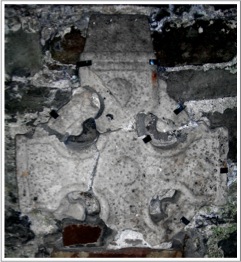
As illustrated in the two photos above, the ringed cross consists of fragments of the original cross: the head has been pieced together and is attached to an inner wall of St. Caimin’s church. The base and shaft are located outside near the round tower.
On the head, as pictured above, three characteristics are clear. There are four bosses, one in the center, one on the upper extension and one each on the arms. Rolled moulding is clearly visible on the cross and the ring. The cap is roof shaped and has no decoration.
What is not so clear in the photos above, but is clarified by the illustration below, is that the bosses are set in a pattern of interlace and the upper left segment of the ring has a meander decoration. Reporting on Inis Cealtra in 1916, Macalister offered illustrations of what the cross may have looked like. (Harbison, 1992, vol. 2, fig. 320)
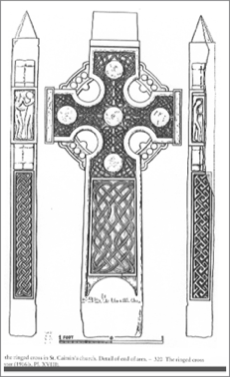
The other face of the cross is against the wall. While parts of it are apparently broken away, Macalister suggests it may have been decorated.
The illustration reveals a figural carving on the end of each arm. On what is identified as the east arm Harbison identifies Samuel Anointing Saul or David. Macalister identifies Adam and Eve. Harbison has this to say about this panel: “Two figures stand opposite one another, clad to above the knees. The figure on the right holds up what seems to be a horn in the left hand, while that on the left extends the right fore-arm.” (Harbison, 1992, p. 99) In the illustration above the clothing described by Harbison is not apparent.
On the end of the west arm Harbison identifies Samuel Kissing Saul or David. The panel is damaged and only one figure is visible. Based on comparison with the East Cross at Galloon another figure is probably present. Any identification is hypothetical. (Harbison, 1992, p. 99)
On the west side of the shaft, facing St. Caimin’s, there is a rectangular panel that according to Macalister contains interlace. At the top is a boss that completes the lower section of the head. The sides of the shaft have interlace. The east face of the shaft is damaged. The lower half contains a square panel. (See photos below, west face left, east face right.)
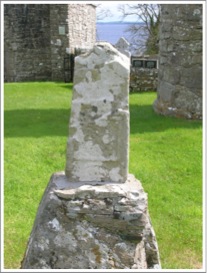
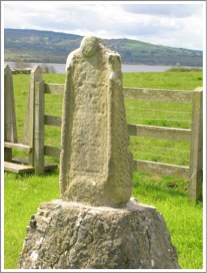
East Cross “Cross of Cathasach”
The East Cross is ringless and stands about 1.6m high. The edges have roll moulding. The surface of the cross is badly worn but Macalister produced a drawing illustrated below. (Harbison, 1992, vol. 3, fig. 1015) This drawing shows a very complex and lovely pattern, or more precisely, patterns of interlace covering the face of the cross.
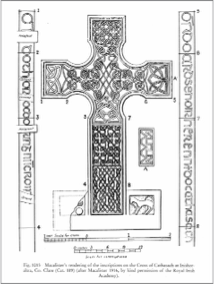
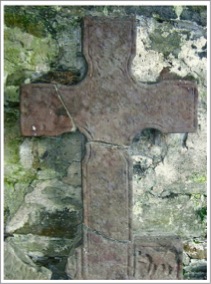
Like the West Cross, there is a rectangular panel on each side of the foot of the cross. The left side is broken off. On the right side there is a panel that shows a quadruped with a human leg hanging from its mouth.
There is an inscription on the east side of the cross that was interpreted by Macalister. It reads “Prayer for Tornoc who made the cross.” This may be a reference to the artist who carved the stone. On the west side is an inscription that reads “Prayer for the Chief Elder of Ireland, i.e. for Cathasach.” This Cathasach is mentioned below. He died in 1087. (Harbison, 1992, p. 98)
West Cross
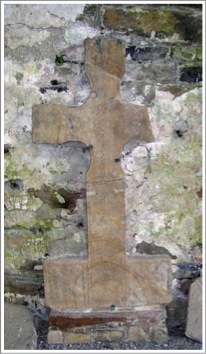
The west cross is ringless and is attached to an inner wall of St. Caimin’s church. It stands about 1.9m high. The right arm is broken. The edges of the cross have roll mouldings. No decoration is visible on the cross.
At the bottom of the cross, on each side of the foot is a square panel. Each bears a St. Andrew’s Cross. The terminals of each cross are squared. Harbison suggests this may imitate a bronze model. (Harbison, 1992, p. 98)
While the sides and back are not visible, Macalister reported that the back was plain.
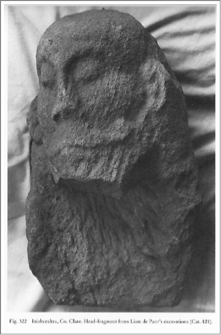
Head Fragment
Liam de Paor (historian, archaeologist and political thinker) discovered a “finely-carved Romanesque head” during an excavation on Inis Cealtra. He identified it as a head of Christ related to a 12th century High Cross. It is in the possession of the National Museum in Dublin.
The head stands out in relief. Christ’s eyes appear to be closed. He has a flowing mustache and a beard. The head is tilted to one side, suggesting that Christ is represented as dead on the cross. (Harbison, 1992, p. 99, Vol. 2 Figure 322) This would make the head, and the cross it was part of, unusual in that on most of the High Crosses, where there is a crucifixion scene, Jesus is depicted with head erect and eyes open, more triumphant than defeated.
The Monastery and Saints
Inis Cealtra is a lovely island located in Loch Derg, just southwest of the Mountshannon harbor and not far from the shore. It is only accessible by boat. In the old Irish the name can be translated literally as Island Church, hence Church Island. . It is also referred to as “Holy Island” (Madden, p. 5) The ruins of numerous buildings are located on the island.
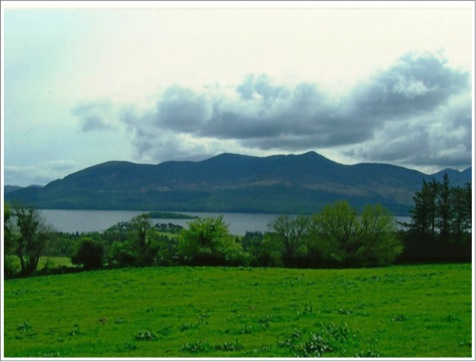
[The photo above looks to the mainland from the island.]
MacCreiche the Anchorite
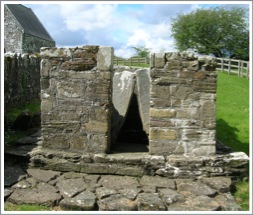
"The first Christian association with the island came in the late fifth or early sixth century when a hermit named MacCreiche moved there and dedicated himself to a life of prayer. (Review, Macalister p. 130) The Confessional or Anchorite’s Cell on the island is said to be the site of his abode. According to tradition it contained four flag-stones “a stone at his back, a stone to each side, and a stone in front of him”. These prevented him from reclining or being comfortable even while he slept. He considered this discomfort part of his penance. (Review, Macalister, p. 132)
[The Confessional is pictured left.]
MacCreiche had a sacred tree. It was a Tilia, a lime or linden tree. Meehan quotes the Acta Sancti Columbae De Tyre Da Glas, a hagiography of Saint Colum mac Crimthan (see below), as reporting in part “a tree by the name of Tilia, whose juice distilling filled a vessel and that liquor had the flavor of honey and the headiness of wine.” (Meehan, pp. 469-70)
Saint Colum mac Crimthan
A monastery was first founded on Inis Cealtra around 520 by St. Colum mac Crimthan, a Leinster saint and one of the Twelve Apostles of Ireland. (Macalister p. 130). The Twelve Apostles were twelve 6th century Irish saints who all studied under St Finian at Clonard Abbey in County Meath. His name is also recorded as Columba or Mac Hy-Crimthainn. This same Colum was associated with the monastery at Terryglass (Tir Dha Ghlas or land of the two streams) in County Tipperary. According to this tradition Inis Cealtra was founded as one of a group of communities St. Colum established in the area of Loch Derg. Hagiography tells us that he was guided there by an angel, and that the same angel guided MacCreiche the anchorite to depart from the island. Colum brought numerous monks with him, a ready made community. Macalister suggests that at some point Colum left the district because it was too heavily populated. (Macalister, p. 130) Madden, on the other hand, believes Colum remained. He bases this on an entry in the Annals of the Four Masters that refers to Marcan, Abbot of Inis (Cealtra d. 1009), as Coarb (successor) of Colum Mac Criomthuinn.
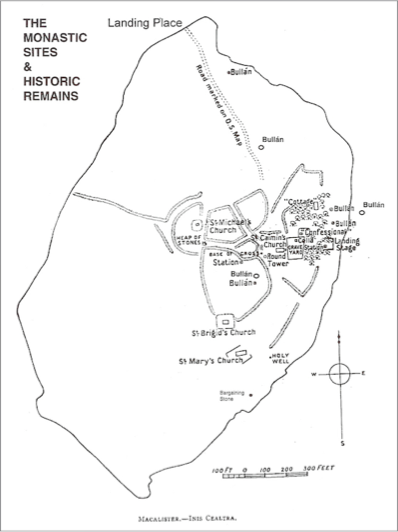
[The map above shows the location of the ruins on Inis Cealtra. http://www.visitclare.net/holyisland.php]
The Annals of the Four Masters reports that “St. Colam, of Inis Cealtra, died of the mortality which was called the Cron Chonaill or Yellow Plague.” (Annals of the Four Masters, M548.9) Peter Berresford Ellis, historian and novelist, notes that “Medical historians agree that the descriptions of The Yellow Plague, referred to in the Irish records as Buidhe Connaill, point to it being a virulent type of jaundice in which the yellowing of the skin and whites of the eyes are a result of excess bilirubin in the blood. Its devastation of Europe, including Ireland, in the 7th Century points to warm climatic conditions at the time as it is usually transmitted by the bite of the female mosquito. (sisterfidelma.com/interview.html)
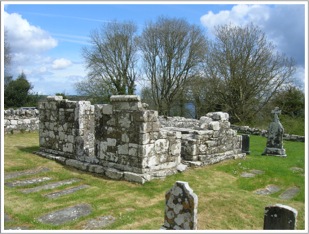
[The photo to the left is the Church of the Wounded Men. It was probably a mortuary chapel for the O’Grady clan. The name may derive from the clan motto: “wounded but not defeated.”] (Madden, p. 27)
Successors to Colum
Several successors to Abbot Colum can be identified. The first was Nadcaoimh, a protege of Colum, who like Colum was also associated with the monastery at Terryglass. Fintan, who had been a student of Colum, followed next. He was succeeded by Colman Stellan. This Colman was one of the clergy of Ireland who received a letter from Pope elect John IV in 640. The letter concerned the Easter controversy. Colman Stellan died in 651. (Madden, p. 7)
Saint Caimin
St Caimin (Caminus, Cammine) is often credited with founding a monastery on Inis Cealtra. Madden believes, based on the work of Liam De Paor, that Caimin either founded a separate foundation or refounded/reformed the existing community. (Madden p. 8)
He is listed as Bishop-Abbot of Inis Cealtra and Terryglass. He was a scholar who wrote a commentary on the Psalms. A fragment of a later copy of his work still exists. Caimin was known for his sanctity and it was under his leadership the monastery developed as a center for learning. (Meehan, p. 470) He died in 654. “Repose of Camíne of Inis Celtra, and of Mael Aithgein, abbot of Tír dá Glas.” (Annals of Innisfallen, AI654.1)
The School at Inis Cealtra
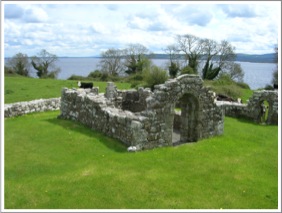
[The photo right is the Church of Saint Bridget at Inis Cealtra.]
The school at Inis Cealtra was of some repute in Ireland and on the continent. Healy described it as “another celebrated nursery of ancient sanctity and learning.” (Healy, 512) It flourished during the seventh and eighth centuries but continued long after. This was a place “where the saints of old sought communion with God, and spent their lives in prayer, and fasting, and sacred study.” (Healy 513) As an example of the emphasis on learning in the monastery it is noted that in addition to Caimin’s commentary on the Psalms, St Coelan (Kalian), a monk of Inis Cealtra who lived in the eighth century, wrote a life of St. Bridget. It is also reported that students came not only from Ireland but from the continent as well.
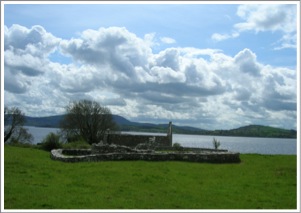
The Eighth Century
Two additional leaders of the monastery, with 8th century dates, are mentioned in the Annals. They are Diarmait and Kellach. The death of Diarmait, an Abbot, is recorded in 749 by the Annals of Innisfallen. For the year 780, the Annals of the Four Masters records the death of Mochtighern, a wise man who was the son of Kellach, Abbot of Inis Cealtra.
[The photo right shows the ruins of St. Bridget’s in the foreground and St. Mary’s church in the background.]
Ninth and Tenth Century
Like so many other monasteries Inis Cealtra was plundered by Vikings. The first time was in 836. The Annals of the Four Masters reports that in that year the Danes burned the churches of Laichtreine, Inis Cealtra and Kill-Finche.
Nearly a century later, in 922, the Annals of Innisfallen record that Tomrar, son of Elgi, a Norseman plundered Inis Cealtra and “drowned (cast into the lough) its shrines and its relics and its books.” In this attack many monks were killed.
We also have information about leaders of the monastery during this period. For the year 898 the Annals of the Four Masters records the death of St. Cosgrath (Coscrach). He was another anchorite who lived and died at Inis Cealtra. He was known as Truaghan (the meagre). Tradition says he used the Anchorite’s Cell of MacCreiche mentioned above. (Review, Macalister, p. 132)
The Annals of the Four Masters mention two tenth century Abbots. They are Diarmaid and Maol-Keallaigh. One citation reads “M.951.4 Diarmaid, son of Caicher, Bishop of Inis-Cealtra died.” The other, a citation for 967, records the death of Maolgorm, the son of Maol-Keallaigh, Abbot of Inis Cealtra.
The Eleventh Century
[The photo below left shows the round tower and St. Caimin’s Church.]
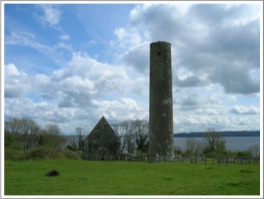
Three inhabitants of the monastery in the eleventh century are noted: Corcran, Marcan and Cathasach.
Corcran was a celebrated scholar and served as Abbot. This suggests that the school at Inis Cealtra and its reputation for learning continued at least into the eleventh century. Marcan, brother of Brian Boraime, King of Munster and High King of Ireland, was abbot there up to his death in 1009. (MacAlister, p. 131) An inscription in stone, on one of the high crosses on the island, identifies Cathasach as “chief of the devout of Ireland”. It records his death in 1087. (MacAlister, p. 130)
An interesting historical side note suggests a close relationship between the monastery and Brian Boraime, king of Munster and High King of Ireland. As noted above, his brother was one of the abbots there. Healy goes on to tell us:
“Brian Boru repaired the great church about that very time, A.D. 1005-1010, and no doubt also restored the efficiency of the schools, for his biographer tells that ‘he sent professors and masters to teach wisdom and knowledge, and to buy books beyond the sea and the great ocean, because their own writings and books, in every church and in every sanctuary where they were, were burned and thrown into the water by the plunderers from first to last, and Brian himself gave the price of learning and the price of books to every one separately who went on this service.’” (Healy, pp. 521-522)
Twelfth Century
When the diocesan system was formalized in Ireland at the Synod of Rathbreasail in 1111, Inis Cealtra was assigned to the diocese of Killaloe. It is not clear when the monastery ceased to function but in 1210 St. Caimin’s church gave way to St. Mary’s as the parish church. After 1615, largely as a result of the Reformation, the buildings on Inis Cealtra were finally all left derelict. (Lewis)
Getting There, a personal journey.
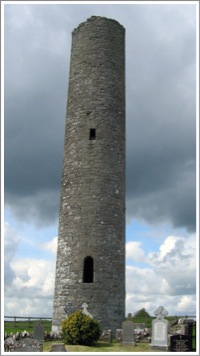
In May of 2008 I was visiting Ireland. The goal of my two week trip was to locate and visit Irish High Crosses. I wanted to see the cross or crosses and to spend some time at each site I was hoping to experience the spirituality of the place. The afternoon of my first day in Ireland I found myself in Kilaloe, a community in County Clare, along the beautiful Shannon River at the south end of Lough Derg. The Information Center there had just opened for the year that very day. The attendants there helped me make contact with a man named Ger Madden. Ger is a local historian who has a special interest in Inis Cealtra. In fact he has written a booklet on the subject “Inis Cealtra: Jewel of the Lough”. He and I made arrangements to meet the next day in the late morning.
[The photo left shows the round tower.]
I found Ger at the Mountshannon marina where he takes folk to the island on a regular basis. I was his only customer for the day, so we took a small motor boat out to the island. He dropped me off at a dock on the north side of the island. He returned to the harbor and left me alone for a couple of hours so I could explore the island in peace.
There's a caretaker on the island who provides some security, maintains the grounds and cares for some cattle. Otherwise the island was deserted. I met the caretaker while he was weed eating in the cemetery. We visited for a few minutes, but mostly I had the island to myself. There are numerous ruins and sacred sites on the island. I was particularly interested in the three crosses described above.
I had purchased a copy of Ger’s book at the harbor so I had a map of the island with the locations and information about the various sites. With or without the booklet the sites are well signposted as the collage below illustrates.
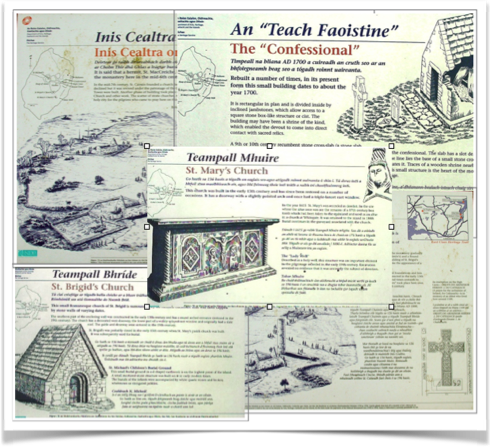
As I moved around the island, from one ancient site to the next I felt the thinness of the place, the presence of the Holy, or, as J. Phillip Newell might say, I found myself “Listening for the The Heartbeat of God.” I thought about the countless souls who had journey here across the centuries in search of God, of holiness, of renewal, of a strong education steeped in scripture, of a community where life was prayer. I thought of those who had and, like me, continue to make pilgrimage to this Holy Island.
A couple of hours later I met Ger at the dock and he took me back to Mountshannon harbor. Dark clouds were rolling in from the southwest and I sat in my car and ate my lunch while it poured rain for a few minutes. By the time I drove away I was refreshed and renewed in body and spirit. I left Inis Cealtra in my wake, looking for more of the sacred places of the Emerald Isle. But it is always in my heart as one of the very special holy places I have visited in Ireland.
Sources Consulted
Celt: Corpus of Electronic Texts, Annals of Ulster AD 431-1201 and Annals of the Four Masters 1 and 2. http://www.ucc.ie/celt/publishd.html
Review by L.G. of, R.A.S. Macalister, The History and Antiquities of Inis Cealtra, Studies: An Irish Quarterly Review, Vol. 6, No. 21, March 1917, Irish Province of the Society of Jesus,
Clare Library, http://www.clarelibrary.ie/eolas/coclare/places/holy_island1.htm, Citing Journal of Thomas Dineley, 1681; A Description in 1845 in County Clare A History and Topography by Samuel Lewis, and records of the Iniscealtra Parish.
Ellis, Peter Berresford, Interview, http://www.sisterfidelma.com/interview.html
Healy, John, Insula sanctorum et doctorum, Sealy, Bryers and Walker, 1890. http://www.clarelibrary.ie/eolas/coclare/places/holy_island1.htm II.
Madden, Gerard, Holy Island: Jewel of the Lough, A History, East Clare Heritage, 1990. Ger continues to offer trips out to the island.
Meehan, Cary, Sacred Ireland, Gothic Image, 2004.